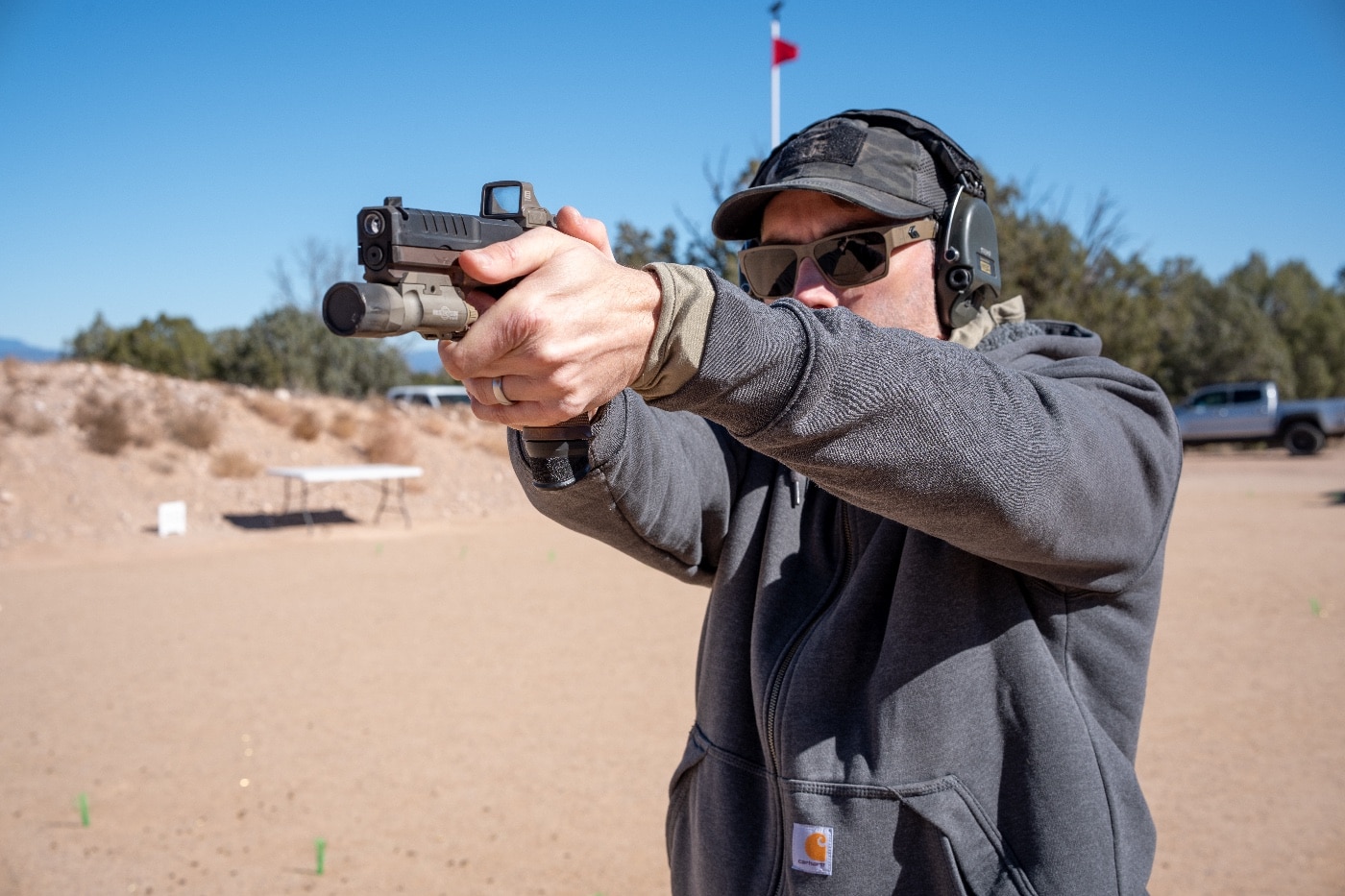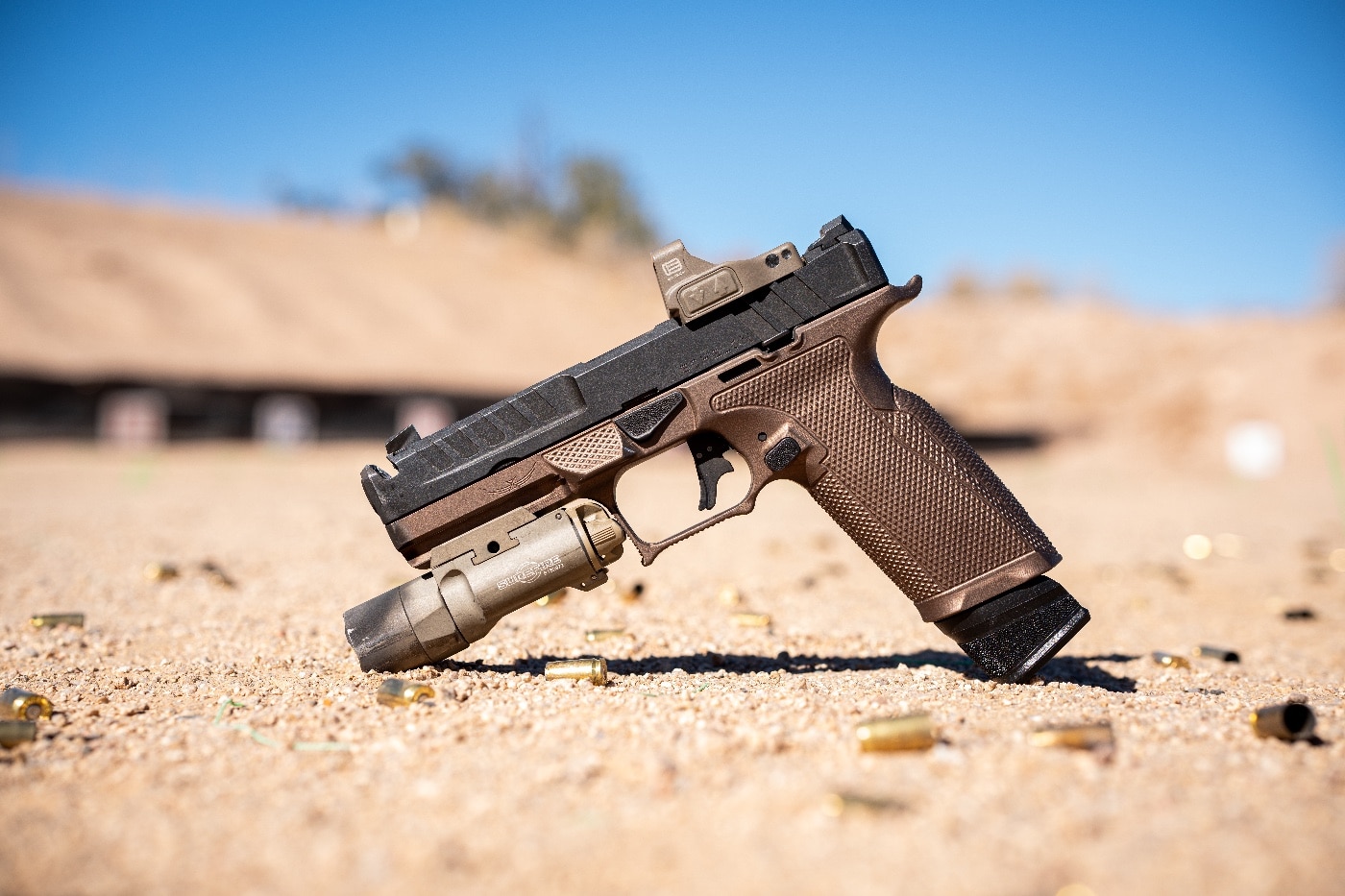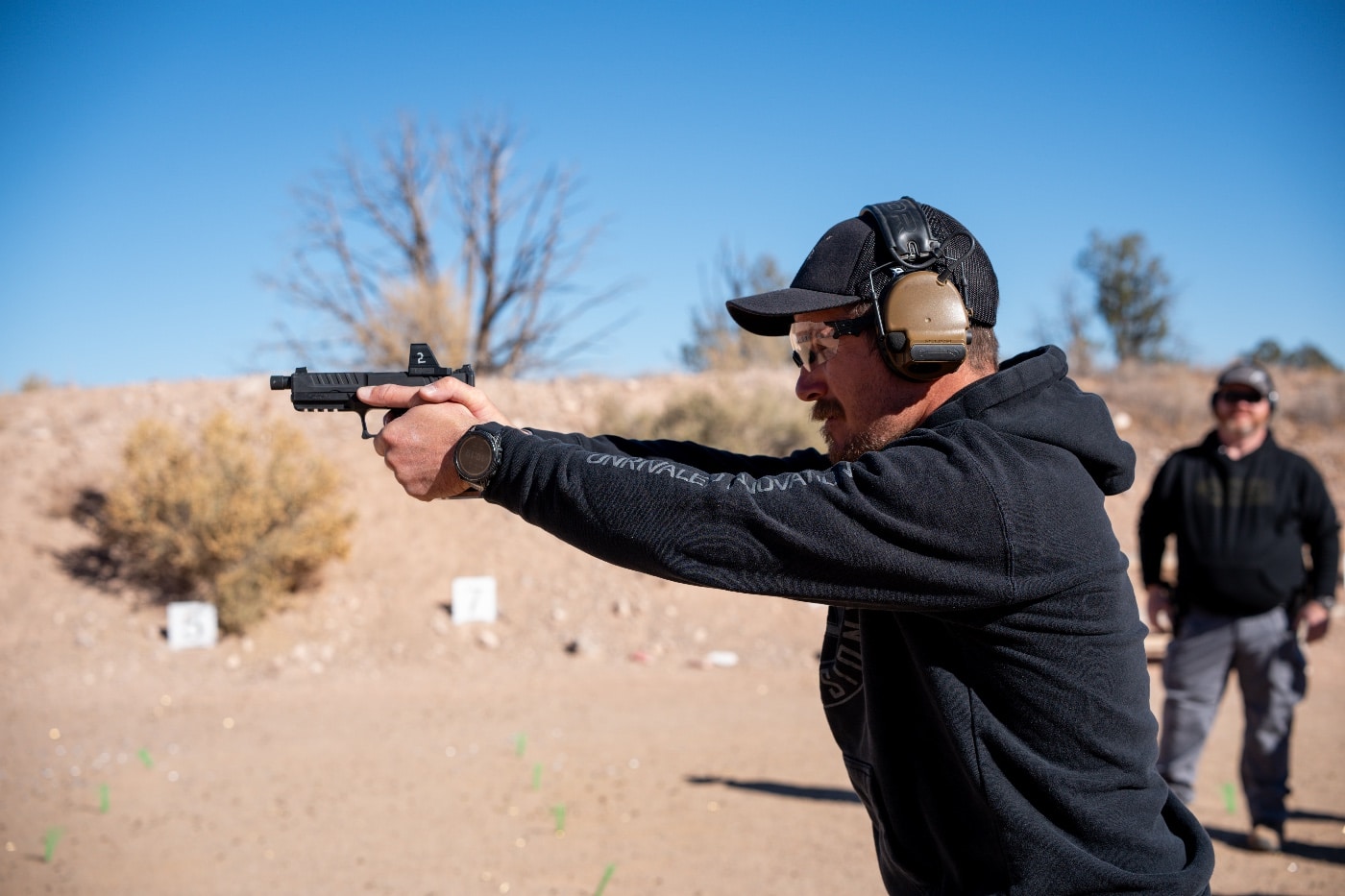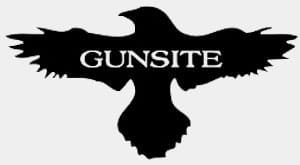Learn to Shoot Like Rob Leatham

Growing up, I rode a lot of BMX in the 90s and early 2000s. I probably rode my bike six or more hours every day commuting to school, hitting some dirt trails or a freestyle concrete park. My friend group and I were never phenomenal riders, but we loved the sport and lived for it.
I remember distinctly one of the older riders explaining to me one day “You will never get better unless you ride with people who are better than you.” I took that to heart and have often called on that memory throughout my life to push past plateaus or get a new perspective on how to overcome obstacles. It can also be a humbling mindset to realize you always have a lot to learn from others who have been where you are and pushed past it into greatness.
I am fortunate to be able to get to the range often and shoot all kinds of firearms, from pistols to rifles and everything in between. One area that has hampered me is that I have not gotten the time to focus on specific platforms or products as much as I would like.
I recently got the opportunity to attend an incredible class at Gunsite Academy with none other than shooting legend Rob Leathem, called “Performance Pistol Symposium”. This class focuses on speed and accuracy for students with a currently advanced skill level in firearms handling and competency. The three-day symposium requires a Gunsite Marksman 1 Level graduate of 350 (or 499) or above. Additionally, the Wilson 5×5 drill is run, requiring a score of 40 or better. Clearly, this is a demanding class.

When I first got the call for the class, I was exhilarated, but a little self-conscious. “Do I have what it takes to attend this class?”. Then, I recalled those important words I heard long ago: “You will never get better unless you ride with people who are better than you.”.
I signed up.
Rob Leatham, with whom I’ve trained in the past and also developed a friendship, invited me out to practice with him a week before the class. I jumped at the opportunity to shake off some of the rust.

I showed up and realized that I was going to be practicing with grand master shooters, running their drills, and not getting a dumbed-down version for the new guy. In short order, I was making five shots in the A-zone at 25 yards in under five seconds from the holster. My time with Rob was clearly a boon, and further proof as to the benefits of training with others much better than myself to learn and grow as a shooter.
Hitting the Ground Running
With the confidence now that I could perform in this class, I showed up to the legendary Gunsite Academy for the first of three days to take my pistol skills to the next level. Rob brought his protégé, Travis McCamish, as an additional trainer, with Gunsite providing Randy Watt and Lew Gosnell as Rangemasters.

It’s worth noting that this class is a slight departure from Gunsite’s traditional structure of defensive gunfighting. The point of the class was taking that structure and elevating the student’s ability to perform with greater speed and accuracy, honing their skill with the pistol to new heights under the tutelage of Rob Leatham.
Rob Leatham has forgotten more about shooting that I will likely ever know. To him it’s as natural as breathing. He doesn’t need to think about shooting; he simply shoots, and the bullets go where he intends them to go. Not only is he an exceptional shooter, but he is also the best instructor I have seen. He can quickly diagnose what you are doing wrong, help you find a solution — and then let you explain what you did or learned to improve.

He doesn’t explain to you every detail or set you up for “gotcha” training. One of the statements he would repeat often is something to the effect of “what I am asking you to do is extremely difficult.” He has no illusions of quick fixes or tips to solve all your problems. Shooting is a perishable skill, and to perform it requires much of you. And, Rob required much of us.
Lew and Randy have had very successful careers within the military and law enforcement communities and have been training students at Gunsite for decades. Their insights and knowledge proved invaluable during the training sessions, quickly identifying where students could improve and working with Rob and Travis to facilitate success for the individuals.

Rob’s teaching companion Travis McCamish is a testament to Rob’s skill in developing shooters. Travis is someone to remember and follow his career. His drive, knowledge and skill level are nearly unmatched. Listening to him speak and watching him shoot helped the class digest and understand what was expected of us during the various drills and tests. During and after shooting strings Rob, Travis, Lew or Randy would come to us and have conversations on small or large things they saw and how we could adapt to achieve a higher level of success. The feedback was immediate. It created an environment for testing, pushing and learning.
The Performance Pistol class reminded me of how elite athletes might train to become 5-10% better. The class wasn’t going over the basics of drawing, grip, stance, etc. Instead, it was discovering the nuance of how you can be faster and more accurate, which will be unique to each student and their journey.
My Ride
For the class, I decided to run my Echelon 4.5F Comp pistol. But you know me, I can’t help but tinker and modify. My goal was to build the ultimate performance version of the Echelon Comp for this class. For the grip module, I used the A.C.E. from Icarus Precision.

The A.C.E. is made from billet 7075 aluminum with an aggressive 360-degree grip texture. Enhancing the ergonomics is a double undercut triggerguard and a generous beavertail for a proper high grip on the pistol, as well as a thumb ledge for support when controlling recoil. The heavier weight of the frame and the great ergonomics made the Echelon 4.5F Comp feel like cheating. When Rob Leatham shot my pistol, he laughed and said, “this pistol doesn’t even move!”. It’s incredibly flat shooting and easy to control.
Knowing that speed and accuracy was the goal of this class, I picked up a Powder River Precision (PRP) trigger kit for the Echelon. While the stock Echelon trigger is one of the best factory striker-fired triggers I have used, I am always looking for that extra bit of performance. The PRP trigger enhances the take-up, trigger travel and reset, and the pull weight comes in at about 3.5 lbs.
Tagging onto the speed and accuracy component, I chose the EOTech EFLX Mini Red Dot for my Echelon build. The large rectangular window creates a generous and natural field of view that is clear of color or lens distortion. The EFLX is durable and easy to zero, and swapping batteries is easy due to its top-loading design. With the EFLX, you also get the EOTech name and all that trust and reputation for quality that goes with it. The EFLX is a DPP footprint, so with the Echelon I didn’t need any mounting plates, just the included pins. The optic was rock steady.
For my holster, I went with QVO Tactical, and I am so glad that I did. Their responsiveness and customer service are second to none. They whipped up the holster with a multicam black fabric wrap and shipped it to my door. Dialing in the perfect retention was simple and intuitive, and the holster looks great while protecting the pistol.
Range Time
The first day of the class was all about finding where the wheels fall off for each of us. How fast can you shoot and still be accurate? How quickly can you operate the trigger until you run out of speed? How quickly can you get off accurate shots under time?

It was great to see so many light bulb moments for students because they were allowed to see where they failed. Going to the red line is a great way to understand where you cannot pass without learning something new. It shows you where you can really perform at speed, and when you need to back off a bit to achieve greater accuracy.
One of the noteworthy tests was performing the Wilson Combat 5×5 drill, which is one of my favorites. The drill is as follows:
String 1: Draw and fire five shots freestyle.
String 2: Draw and fire five shots strong-hand-only.
String 3: Start with only five rounds in your gun. Draw and fire five shots, emergency reload, and fire five additional shots freestyle.
String 4: Draw and fire four shots to the target body and one shot to the target head, freestyle.
You then add your time as a total. For shots outside the scoring zones, you add .5, 1.5, or 2.5 seconds depending on the zone.

The scoring is as follows:
- Master: 18.47 or less
- Expert: 18.48–22.93
- Sharpshooter: 22.94–28.39
- Marksman: 28.40–36.18
- Novice: 36.19 or greater
My time was in order of strings: 3.77, 4.67, 7.76, 4.46, with two shots right outside the scoring zone. This put my total score at 21.66, which is in the Expert category. Prior to this class, my score on the Wilson 5×5 was 28.44. It was great to see a measurable increase in my skill!
On the third day, we continued to practice speed and accuracy from the holster at 3, 7, 10, 15 and 25 yards with various times and round counts. Rob also introduced target transitions and explained moving the pistol immediately after breaking the shot to save time on the transition. This would come in handy for the final part of the class, where the instructors set up four stages with steel targets.
Each stage focused on different targets at distance, shot in specific order and under time. It was a great way to test in a friendly competitive manner the skills we had been honing over the last three days. Shooting steel and hearing that immediate feedback gets your blood pumping and creates excitement for everyone else watching. It was really cool to see everyone performing at a high level throughout the class and seeing their scores stack up against each other. There were some truly impressive individuals in the class, and it made me proud to train alongside them.
Conclusion
Leaving the class, I have a couple things that I am excited to work through — mostly to do with being faster to acquire my red dot on the draw. I get to shoot a lot of pistols, but I don’t always get enough practice on the draw. That is my main takeaway, and it just comes from getting in more reps. As Travis said, “Pointing the gun is the most important thing. Learn to operate the gun while keeping the gun oriented on the target”. Simple, right?
Overall, the feedback from the higher-ups at Gunsite and the students seemed to indicate a resounding success for the Performance Pistol Symposium class.
Editor’s Note: Please be sure to check out The Armory Life Forum, where you can comment about our daily articles, as well as just talk guns and gear. Click the “Go To Forum Thread” link below to jump in!
Join the Discussion
Featured in this video
Read the full article here








![Best 10mm 1911 Pistols [Field Tested] Best 10mm 1911 Pistols [Field Tested]](https://i3.wp.com/gundigest.com/wp-content/uploads/10mm-1911-feature-colt-delta-elite.jpg?w=390&resize=390,220&ssl=1)




